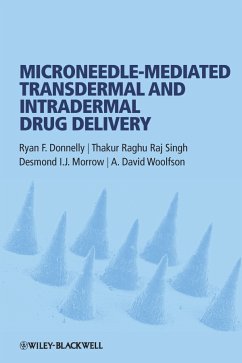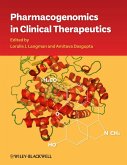Ryan F. Donnelly, Thakur Raghu Raj Singh, Desmond I. J. Morrow, A. David Woolfson
Microneedle-mediated Transdermal and Intradermal Drug Delivery (eBook, ePUB)
110,99 €
110,99 €
inkl. MwSt.
Sofort per Download lieferbar

0 °P sammeln
110,99 €
Als Download kaufen

110,99 €
inkl. MwSt.
Sofort per Download lieferbar

0 °P sammeln
Jetzt verschenken
Alle Infos zum eBook verschenken
110,99 €
inkl. MwSt.
Sofort per Download lieferbar
Alle Infos zum eBook verschenken

0 °P sammeln
Ryan F. Donnelly, Thakur Raghu Raj Singh, Desmond I. J. Morrow, A. David Woolfson
Microneedle-mediated Transdermal and Intradermal Drug Delivery (eBook, ePUB)
- Format: ePub
- Merkliste
- Auf die Merkliste
- Bewerten Bewerten
- Teilen
- Produkt teilen
- Produkterinnerung
- Produkterinnerung

Bitte loggen Sie sich zunächst in Ihr Kundenkonto ein oder registrieren Sie sich bei
bücher.de, um das eBook-Abo tolino select nutzen zu können.
Hier können Sie sich einloggen
Hier können Sie sich einloggen
Sie sind bereits eingeloggt. Klicken Sie auf 2. tolino select Abo, um fortzufahren.

Bitte loggen Sie sich zunächst in Ihr Kundenkonto ein oder registrieren Sie sich bei bücher.de, um das eBook-Abo tolino select nutzen zu können.
Microneedles can be used for delivery of a wide range of drug substances for practically any medical condition and present a real opportunity for vaccines and medicines that are unsuitable for oral administration or conventional patch delivery. Microneedle-mediated Transdermal and Intradermal Drug Delivery covers the major aspects relating to the use of microneedle arrays in enhancing drug delivery applications. It provides an overview of the various methods employed to design and produce microneedles, from the different materials involved to the importance of application methods. It carefully…mehr
- Geräte: eReader
- mit Kopierschutz
- eBook Hilfe
- Größe: 2.42MB
Andere Kunden interessierten sich auch für
![Microneedle-mediated Transdermal and Intradermal Drug Delivery (eBook, PDF) Microneedle-mediated Transdermal and Intradermal Drug Delivery (eBook, PDF)]() Ryan F. DonnellyMicroneedle-mediated Transdermal and Intradermal Drug Delivery (eBook, PDF)110,99 €
Ryan F. DonnellyMicroneedle-mediated Transdermal and Intradermal Drug Delivery (eBook, PDF)110,99 €![Mann's Pharmacovigilance (eBook, ePUB) Mann's Pharmacovigilance (eBook, ePUB)]() Mann's Pharmacovigilance (eBook, ePUB)242,99 €
Mann's Pharmacovigilance (eBook, ePUB)242,99 €![Pharmacogenomics in Clinical Therapeutics (eBook, ePUB) Pharmacogenomics in Clinical Therapeutics (eBook, ePUB)]() Pharmacogenomics in Clinical Therapeutics (eBook, ePUB)102,99 €
Pharmacogenomics in Clinical Therapeutics (eBook, ePUB)102,99 €![Stephens' Detection and Evaluation of Adverse Drug Reactions (eBook, ePUB) Stephens' Detection and Evaluation of Adverse Drug Reactions (eBook, ePUB)]() Stephens' Detection and Evaluation of Adverse Drug Reactions (eBook, ePUB)288,99 €
Stephens' Detection and Evaluation of Adverse Drug Reactions (eBook, ePUB)288,99 €![Clinical Pharmacology and Therapeutics (eBook, ePUB) Clinical Pharmacology and Therapeutics (eBook, ePUB)]() Clinical Pharmacology and Therapeutics (eBook, ePUB)35,99 €
Clinical Pharmacology and Therapeutics (eBook, ePUB)35,99 €![Nanomedicine for Drug Delivery and Therapeutics (eBook, ePUB) Nanomedicine for Drug Delivery and Therapeutics (eBook, ePUB)]() Nanomedicine for Drug Delivery and Therapeutics (eBook, ePUB)186,99 €
Nanomedicine for Drug Delivery and Therapeutics (eBook, ePUB)186,99 €![The Textbook of Pharmaceutical Medicine (eBook, ePUB) The Textbook of Pharmaceutical Medicine (eBook, ePUB)]() The Textbook of Pharmaceutical Medicine (eBook, ePUB)224,99 €
The Textbook of Pharmaceutical Medicine (eBook, ePUB)224,99 €-
-
-
Microneedles can be used for delivery of a wide range of drug substances for practically any medical condition and present a real opportunity for vaccines and medicines that are unsuitable for oral administration or conventional patch delivery. Microneedle-mediated Transdermal and Intradermal Drug Delivery covers the major aspects relating to the use of microneedle arrays in enhancing drug delivery applications. It provides an overview of the various methods employed to design and produce microneedles, from the different materials involved to the importance of application methods. It carefully and critically reviews ongoing transdermal and intradermal delivery research using microneedles and includes the outcomes of in vivo animal and human studies. Importantly, it also discusses the safety and patient acceptability studies carried out to date. Finally, the book reviews the recent patents in microneedle research and describes the ongoing developments within industry that will determine the future of microneedle-mediated transdermal and intradermal drug delivery. By an expert author team with practical experience in the design and development of drug delivery systems this is the only text that provides a comprehensive review of microneedle research in transdermal and intradermal drug delivery.
Dieser Download kann aus rechtlichen Gründen nur mit Rechnungsadresse in D ausgeliefert werden.
Produktdetails
- Produktdetails
- Verlag: John Wiley & Sons
- Erscheinungstermin: 17. Januar 2012
- Englisch
- ISBN-13: 9781119959663
- Artikelnr.: 38460382
- Verlag: John Wiley & Sons
- Erscheinungstermin: 17. Januar 2012
- Englisch
- ISBN-13: 9781119959663
- Artikelnr.: 38460382
- Herstellerkennzeichnung Die Herstellerinformationen sind derzeit nicht verfügbar.
Ryan F. Donnelly, Senior Lecturer in Pharmaceutics, School of Pharmacy, Queen's University Belfast, UK
Thakur Raghu Raj Singh, Lecturer in Pharmaceutics, School of Pharmacy, Queen's University Belfast, UK
Desmond I.J. Morrow, Honorary Research Fellow, School of Pharmacy, Queen's University Belfast, UK
A. David Woolfson, Chair in Pharmaceutics and Head of the School of Pharmacy, Queen's University Belfast, UK
Thakur Raghu Raj Singh, Lecturer in Pharmaceutics, School of Pharmacy, Queen's University Belfast, UK
Desmond I.J. Morrow, Honorary Research Fellow, School of Pharmacy, Queen's University Belfast, UK
A. David Woolfson, Chair in Pharmaceutics and Head of the School of Pharmacy, Queen's University Belfast, UK
Preface, ix
About the Authors, xiii
1 Transdermal Drug Delivery, 1
1.1 Genesis of transdermal drug delivery, 1
1.2 Skin anatomy, 2
1.2.1 The epidermis, 2
1.2.2 The stratum corneum, 4
1.2.3 The dermis, 6
1.2.4 Skin appendages, 6
1.3 Routes to percutaneous drug absorption, 7
1.4 Facilitated transdermal drug delivery, 11
1.4.1 Cryopneumatic and photopneumatic technologies, 12
1.4.2 Sonophoresis (low-frequency ultrasound), 12
1.4.3 Iontophoresis, 13
1.4.4 Electroporation, 14
1.4.5 Jet injection, 14
1.4.6 Microneedles, 15
References, 15
2 Microneedles: Design, Microfabrication and Optimization, 20
2.1 Introduction, 20
2.2 Methods of fabricating microneedles, 21
2.2.1 Microfabrication of silicon microneedles, 22
2.2.2 Microfabrication of metal and other types of MNs, 31
2.2.3 Microfabrication of polymeric microneedles, 34
2.3 Optimization to MN design for transdermal drug delivery, 46
2.4 Conclusion, 49
References, 51
3 Microneedle Applicator Designs for Transdermal Drug Delivery
Applications, 57
3.1 Introduction, 57
3.2 Considerations of microneedle applicators designs, 72
3.3 Conclusion, 76
References, 76
4 Transdermal Delivery Applications, 79
4.1 Introduction, 79
4.2 Transdermal drug delivery, 79
4.2.1 Partition co-efficient between 1 and 3, 80
4.2.2 A relatively low melting point, 80
4.2.3 A molecular weight less than 500 Da, 81
4.2.4 Unionized, 81
4.3 Modulation of transdermal penetration using microneedles, 82
4.4 Transdermal delivery using solid microneedles, 83
4.4.1 Transdermal delivery of low molecular weight compounds (RMM < 600 Da)
in vitro using solid microneedles, 84
4.4.2 Transdermal delivery of low molecular weight compounds (RMM < 600 Da)
in vivo using solid microneedles, 86
> 600 Da) in vitro using solid microneedles, 88
> 600 Da) in vivo using solid microneedles, 89
4.5 Transdermal delivery using hollow microneedles, 91
4.5.1 Transdermal delivery of low molecular weight compounds (RMM < 600 Da)
in vitro using hollow microneedles, 91
4.5.2 Transdermal delivery of low molecular weight compounds (RMM < 600 Da)
in vivo using hollow microneedles, 92
> 600 Da) in vitro using hollow microneedles, 93
> 600 Da) in vivo using hollow microneedles, 93
4.6 Transdermal delivery using biodegradable microneedles, 96
4.6.1 Transdermal delivery of low molecular weight compounds in vitro
using biodegradable MN, 96
4.6.2 Transdermal delivery of low molecular weight compounds in vivo using
biodegradable MN, 98
4.6.3 Transdermal delivery of high molecular weight
compounds in vitro using biodegradable MN, 98
4.6.4 Transdermal delivery of high molecular weight compounds in vivo
using biodegradable MN, 100
4.7 Microneedles in combination with other enhancement strategies, 102
4.8 Conclusion, 105
References, 107
5 Microneedle-mediated Intradermal Delivery, 113
5.1 Introduction, 113
5.2 Vaccine delivery, 113
5.2.1 Vaccination, 113
5.3 Intradermal vaccination, 116
5.3.1 Skin structure, 117
5.3.2 Skin immune response, 117
5.3.3 Conventional strategies for intradermal vaccine delivery, 118
5.3.4 Coated microneedles, 120
5.3.5 'Poke and Patch' approaches, 129
5.3.6 Hollow microneedles, 131
5.3.7 Dissolving/biodegrading polymeric microneedles, 133
5.3.8 Epidermal gene delivery, 135
5.4 Intradermal delivery of photosensitizers for photodynamic therapy, 139
5.4.1 Microneedle-mediated intradermal delivery of 5-aminolevulinic acid
and derivatives, 141
5.4.2 Microneedle-mediated intradermal delivery of preformed
photosensitizers, 143
5.5 Intradermal delivery of nanoparticles, 144
5.6 Conclusion, 146
References, 147
6 Clinical Application and Safety Studies of Microneedles, 152
6.1 Introduction, 152
6.2 Clinical and safety consideration for MN application, 153
6.2.1 Sensation of pain, 153
6.2.2 Recovery of micropores and possibility of infection following
microneedle application, 155
6.2.3 Erythema, 156
6.2.4 Biocompatability and biodegradation of MN material, 157
6.3 Conclusion, 159
References, 160
7 Microneedles: Current Status and Future Perspectives, 164
7.1 Introduction, 164
7.2 Biological fluid sampling devices, 167
7.3 Ocular drug delivery, 172
7.4 Cosmetic applications, 175
7.5 Industrial perspectives, 177
7.6 Hydrogel-forming microneedle arrays, 179
7.7 Moving forwards, 181
7.8 Conclusion, 184
References, 185
Index, 188
About the Authors, xiii
1 Transdermal Drug Delivery, 1
1.1 Genesis of transdermal drug delivery, 1
1.2 Skin anatomy, 2
1.2.1 The epidermis, 2
1.2.2 The stratum corneum, 4
1.2.3 The dermis, 6
1.2.4 Skin appendages, 6
1.3 Routes to percutaneous drug absorption, 7
1.4 Facilitated transdermal drug delivery, 11
1.4.1 Cryopneumatic and photopneumatic technologies, 12
1.4.2 Sonophoresis (low-frequency ultrasound), 12
1.4.3 Iontophoresis, 13
1.4.4 Electroporation, 14
1.4.5 Jet injection, 14
1.4.6 Microneedles, 15
References, 15
2 Microneedles: Design, Microfabrication and Optimization, 20
2.1 Introduction, 20
2.2 Methods of fabricating microneedles, 21
2.2.1 Microfabrication of silicon microneedles, 22
2.2.2 Microfabrication of metal and other types of MNs, 31
2.2.3 Microfabrication of polymeric microneedles, 34
2.3 Optimization to MN design for transdermal drug delivery, 46
2.4 Conclusion, 49
References, 51
3 Microneedle Applicator Designs for Transdermal Drug Delivery
Applications, 57
3.1 Introduction, 57
3.2 Considerations of microneedle applicators designs, 72
3.3 Conclusion, 76
References, 76
4 Transdermal Delivery Applications, 79
4.1 Introduction, 79
4.2 Transdermal drug delivery, 79
4.2.1 Partition co-efficient between 1 and 3, 80
4.2.2 A relatively low melting point, 80
4.2.3 A molecular weight less than 500 Da, 81
4.2.4 Unionized, 81
4.3 Modulation of transdermal penetration using microneedles, 82
4.4 Transdermal delivery using solid microneedles, 83
4.4.1 Transdermal delivery of low molecular weight compounds (RMM < 600 Da)
in vitro using solid microneedles, 84
4.4.2 Transdermal delivery of low molecular weight compounds (RMM < 600 Da)
in vivo using solid microneedles, 86
> 600 Da) in vitro using solid microneedles, 88
> 600 Da) in vivo using solid microneedles, 89
4.5 Transdermal delivery using hollow microneedles, 91
4.5.1 Transdermal delivery of low molecular weight compounds (RMM < 600 Da)
in vitro using hollow microneedles, 91
4.5.2 Transdermal delivery of low molecular weight compounds (RMM < 600 Da)
in vivo using hollow microneedles, 92
> 600 Da) in vitro using hollow microneedles, 93
> 600 Da) in vivo using hollow microneedles, 93
4.6 Transdermal delivery using biodegradable microneedles, 96
4.6.1 Transdermal delivery of low molecular weight compounds in vitro
using biodegradable MN, 96
4.6.2 Transdermal delivery of low molecular weight compounds in vivo using
biodegradable MN, 98
4.6.3 Transdermal delivery of high molecular weight
compounds in vitro using biodegradable MN, 98
4.6.4 Transdermal delivery of high molecular weight compounds in vivo
using biodegradable MN, 100
4.7 Microneedles in combination with other enhancement strategies, 102
4.8 Conclusion, 105
References, 107
5 Microneedle-mediated Intradermal Delivery, 113
5.1 Introduction, 113
5.2 Vaccine delivery, 113
5.2.1 Vaccination, 113
5.3 Intradermal vaccination, 116
5.3.1 Skin structure, 117
5.3.2 Skin immune response, 117
5.3.3 Conventional strategies for intradermal vaccine delivery, 118
5.3.4 Coated microneedles, 120
5.3.5 'Poke and Patch' approaches, 129
5.3.6 Hollow microneedles, 131
5.3.7 Dissolving/biodegrading polymeric microneedles, 133
5.3.8 Epidermal gene delivery, 135
5.4 Intradermal delivery of photosensitizers for photodynamic therapy, 139
5.4.1 Microneedle-mediated intradermal delivery of 5-aminolevulinic acid
and derivatives, 141
5.4.2 Microneedle-mediated intradermal delivery of preformed
photosensitizers, 143
5.5 Intradermal delivery of nanoparticles, 144
5.6 Conclusion, 146
References, 147
6 Clinical Application and Safety Studies of Microneedles, 152
6.1 Introduction, 152
6.2 Clinical and safety consideration for MN application, 153
6.2.1 Sensation of pain, 153
6.2.2 Recovery of micropores and possibility of infection following
microneedle application, 155
6.2.3 Erythema, 156
6.2.4 Biocompatability and biodegradation of MN material, 157
6.3 Conclusion, 159
References, 160
7 Microneedles: Current Status and Future Perspectives, 164
7.1 Introduction, 164
7.2 Biological fluid sampling devices, 167
7.3 Ocular drug delivery, 172
7.4 Cosmetic applications, 175
7.5 Industrial perspectives, 177
7.6 Hydrogel-forming microneedle arrays, 179
7.7 Moving forwards, 181
7.8 Conclusion, 184
References, 185
Index, 188
Preface, ix
About the Authors, xiii
1 Transdermal Drug Delivery, 1
1.1 Genesis of transdermal drug delivery, 1
1.2 Skin anatomy, 2
1.2.1 The epidermis, 2
1.2.2 The stratum corneum, 4
1.2.3 The dermis, 6
1.2.4 Skin appendages, 6
1.3 Routes to percutaneous drug absorption, 7
1.4 Facilitated transdermal drug delivery, 11
1.4.1 Cryopneumatic and photopneumatic technologies, 12
1.4.2 Sonophoresis (low-frequency ultrasound), 12
1.4.3 Iontophoresis, 13
1.4.4 Electroporation, 14
1.4.5 Jet injection, 14
1.4.6 Microneedles, 15
References, 15
2 Microneedles: Design, Microfabrication and Optimization, 20
2.1 Introduction, 20
2.2 Methods of fabricating microneedles, 21
2.2.1 Microfabrication of silicon microneedles, 22
2.2.2 Microfabrication of metal and other types of MNs, 31
2.2.3 Microfabrication of polymeric microneedles, 34
2.3 Optimization to MN design for transdermal drug delivery, 46
2.4 Conclusion, 49
References, 51
3 Microneedle Applicator Designs for Transdermal Drug Delivery
Applications, 57
3.1 Introduction, 57
3.2 Considerations of microneedle applicators designs, 72
3.3 Conclusion, 76
References, 76
4 Transdermal Delivery Applications, 79
4.1 Introduction, 79
4.2 Transdermal drug delivery, 79
4.2.1 Partition co-efficient between 1 and 3, 80
4.2.2 A relatively low melting point, 80
4.2.3 A molecular weight less than 500 Da, 81
4.2.4 Unionized, 81
4.3 Modulation of transdermal penetration using microneedles, 82
4.4 Transdermal delivery using solid microneedles, 83
4.4.1 Transdermal delivery of low molecular weight compounds (RMM < 600 Da)
in vitro using solid microneedles, 84
4.4.2 Transdermal delivery of low molecular weight compounds (RMM < 600 Da)
in vivo using solid microneedles, 86
> 600 Da) in vitro using solid microneedles, 88
> 600 Da) in vivo using solid microneedles, 89
4.5 Transdermal delivery using hollow microneedles, 91
4.5.1 Transdermal delivery of low molecular weight compounds (RMM < 600 Da)
in vitro using hollow microneedles, 91
4.5.2 Transdermal delivery of low molecular weight compounds (RMM < 600 Da)
in vivo using hollow microneedles, 92
> 600 Da) in vitro using hollow microneedles, 93
> 600 Da) in vivo using hollow microneedles, 93
4.6 Transdermal delivery using biodegradable microneedles, 96
4.6.1 Transdermal delivery of low molecular weight compounds in vitro
using biodegradable MN, 96
4.6.2 Transdermal delivery of low molecular weight compounds in vivo using
biodegradable MN, 98
4.6.3 Transdermal delivery of high molecular weight
compounds in vitro using biodegradable MN, 98
4.6.4 Transdermal delivery of high molecular weight compounds in vivo
using biodegradable MN, 100
4.7 Microneedles in combination with other enhancement strategies, 102
4.8 Conclusion, 105
References, 107
5 Microneedle-mediated Intradermal Delivery, 113
5.1 Introduction, 113
5.2 Vaccine delivery, 113
5.2.1 Vaccination, 113
5.3 Intradermal vaccination, 116
5.3.1 Skin structure, 117
5.3.2 Skin immune response, 117
5.3.3 Conventional strategies for intradermal vaccine delivery, 118
5.3.4 Coated microneedles, 120
5.3.5 'Poke and Patch' approaches, 129
5.3.6 Hollow microneedles, 131
5.3.7 Dissolving/biodegrading polymeric microneedles, 133
5.3.8 Epidermal gene delivery, 135
5.4 Intradermal delivery of photosensitizers for photodynamic therapy, 139
5.4.1 Microneedle-mediated intradermal delivery of 5-aminolevulinic acid
and derivatives, 141
5.4.2 Microneedle-mediated intradermal delivery of preformed
photosensitizers, 143
5.5 Intradermal delivery of nanoparticles, 144
5.6 Conclusion, 146
References, 147
6 Clinical Application and Safety Studies of Microneedles, 152
6.1 Introduction, 152
6.2 Clinical and safety consideration for MN application, 153
6.2.1 Sensation of pain, 153
6.2.2 Recovery of micropores and possibility of infection following
microneedle application, 155
6.2.3 Erythema, 156
6.2.4 Biocompatability and biodegradation of MN material, 157
6.3 Conclusion, 159
References, 160
7 Microneedles: Current Status and Future Perspectives, 164
7.1 Introduction, 164
7.2 Biological fluid sampling devices, 167
7.3 Ocular drug delivery, 172
7.4 Cosmetic applications, 175
7.5 Industrial perspectives, 177
7.6 Hydrogel-forming microneedle arrays, 179
7.7 Moving forwards, 181
7.8 Conclusion, 184
References, 185
Index, 188
About the Authors, xiii
1 Transdermal Drug Delivery, 1
1.1 Genesis of transdermal drug delivery, 1
1.2 Skin anatomy, 2
1.2.1 The epidermis, 2
1.2.2 The stratum corneum, 4
1.2.3 The dermis, 6
1.2.4 Skin appendages, 6
1.3 Routes to percutaneous drug absorption, 7
1.4 Facilitated transdermal drug delivery, 11
1.4.1 Cryopneumatic and photopneumatic technologies, 12
1.4.2 Sonophoresis (low-frequency ultrasound), 12
1.4.3 Iontophoresis, 13
1.4.4 Electroporation, 14
1.4.5 Jet injection, 14
1.4.6 Microneedles, 15
References, 15
2 Microneedles: Design, Microfabrication and Optimization, 20
2.1 Introduction, 20
2.2 Methods of fabricating microneedles, 21
2.2.1 Microfabrication of silicon microneedles, 22
2.2.2 Microfabrication of metal and other types of MNs, 31
2.2.3 Microfabrication of polymeric microneedles, 34
2.3 Optimization to MN design for transdermal drug delivery, 46
2.4 Conclusion, 49
References, 51
3 Microneedle Applicator Designs for Transdermal Drug Delivery
Applications, 57
3.1 Introduction, 57
3.2 Considerations of microneedle applicators designs, 72
3.3 Conclusion, 76
References, 76
4 Transdermal Delivery Applications, 79
4.1 Introduction, 79
4.2 Transdermal drug delivery, 79
4.2.1 Partition co-efficient between 1 and 3, 80
4.2.2 A relatively low melting point, 80
4.2.3 A molecular weight less than 500 Da, 81
4.2.4 Unionized, 81
4.3 Modulation of transdermal penetration using microneedles, 82
4.4 Transdermal delivery using solid microneedles, 83
4.4.1 Transdermal delivery of low molecular weight compounds (RMM < 600 Da)
in vitro using solid microneedles, 84
4.4.2 Transdermal delivery of low molecular weight compounds (RMM < 600 Da)
in vivo using solid microneedles, 86
> 600 Da) in vitro using solid microneedles, 88
> 600 Da) in vivo using solid microneedles, 89
4.5 Transdermal delivery using hollow microneedles, 91
4.5.1 Transdermal delivery of low molecular weight compounds (RMM < 600 Da)
in vitro using hollow microneedles, 91
4.5.2 Transdermal delivery of low molecular weight compounds (RMM < 600 Da)
in vivo using hollow microneedles, 92
> 600 Da) in vitro using hollow microneedles, 93
> 600 Da) in vivo using hollow microneedles, 93
4.6 Transdermal delivery using biodegradable microneedles, 96
4.6.1 Transdermal delivery of low molecular weight compounds in vitro
using biodegradable MN, 96
4.6.2 Transdermal delivery of low molecular weight compounds in vivo using
biodegradable MN, 98
4.6.3 Transdermal delivery of high molecular weight
compounds in vitro using biodegradable MN, 98
4.6.4 Transdermal delivery of high molecular weight compounds in vivo
using biodegradable MN, 100
4.7 Microneedles in combination with other enhancement strategies, 102
4.8 Conclusion, 105
References, 107
5 Microneedle-mediated Intradermal Delivery, 113
5.1 Introduction, 113
5.2 Vaccine delivery, 113
5.2.1 Vaccination, 113
5.3 Intradermal vaccination, 116
5.3.1 Skin structure, 117
5.3.2 Skin immune response, 117
5.3.3 Conventional strategies for intradermal vaccine delivery, 118
5.3.4 Coated microneedles, 120
5.3.5 'Poke and Patch' approaches, 129
5.3.6 Hollow microneedles, 131
5.3.7 Dissolving/biodegrading polymeric microneedles, 133
5.3.8 Epidermal gene delivery, 135
5.4 Intradermal delivery of photosensitizers for photodynamic therapy, 139
5.4.1 Microneedle-mediated intradermal delivery of 5-aminolevulinic acid
and derivatives, 141
5.4.2 Microneedle-mediated intradermal delivery of preformed
photosensitizers, 143
5.5 Intradermal delivery of nanoparticles, 144
5.6 Conclusion, 146
References, 147
6 Clinical Application and Safety Studies of Microneedles, 152
6.1 Introduction, 152
6.2 Clinical and safety consideration for MN application, 153
6.2.1 Sensation of pain, 153
6.2.2 Recovery of micropores and possibility of infection following
microneedle application, 155
6.2.3 Erythema, 156
6.2.4 Biocompatability and biodegradation of MN material, 157
6.3 Conclusion, 159
References, 160
7 Microneedles: Current Status and Future Perspectives, 164
7.1 Introduction, 164
7.2 Biological fluid sampling devices, 167
7.3 Ocular drug delivery, 172
7.4 Cosmetic applications, 175
7.5 Industrial perspectives, 177
7.6 Hydrogel-forming microneedle arrays, 179
7.7 Moving forwards, 181
7.8 Conclusion, 184
References, 185
Index, 188







